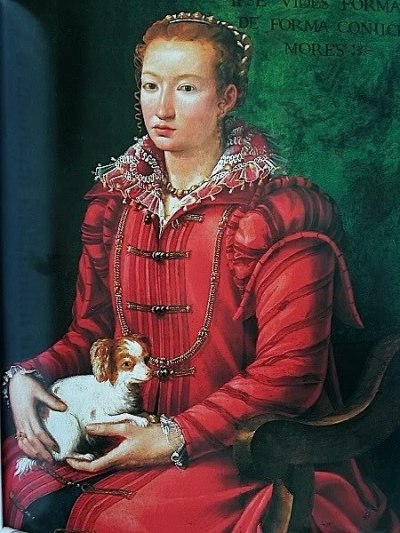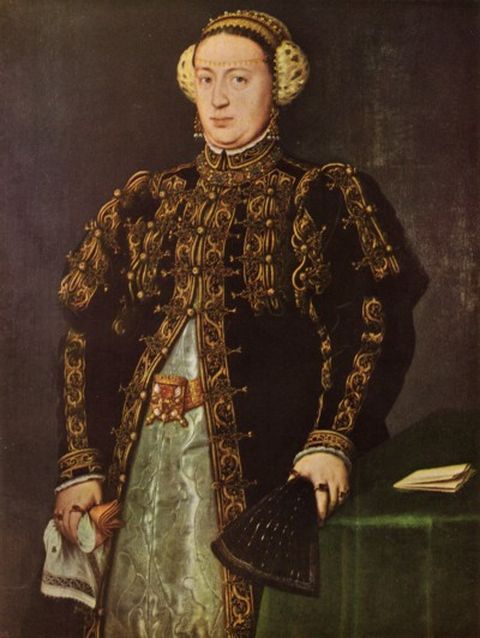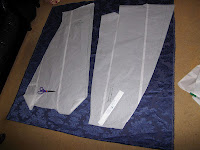 |
| The finished over-gown |
I have needed a warm over-gown for some time, so the Realm of Venus ‘Over and Above’ Mini-challenge was a great opportunity to get motivated and produce a finished item quickly. (I have some significant health challenges, so I normally never get anything done quickly!)
Initially, I prepared by spending time looking at portraits and woodcuts from the sixteenth century. I predominantly wear mid-sixteenth century Italian and English garb, so it was very important that my over-gown be accurate and appropriate for both Italian and English courts.
Sometimes choosing a style can be the hardest part of the project, and I certainly found it very difficult. In the end, I chose the fabric that I wanted to use and narrowed down my style options from there. I am on a very strict budget, so using what I had seemed the most sensible and practical option. I chose this fabric which I got cheaply as a remnant. The colour would match most of my wardrobe, and the design is very similar to many sixteenth century silk damasks. The fabric is most likely a poly-cotton blend. I prefer 100% natural fabrics as being more historically accurate and nicer to wear, but my budget simply doesn’t extend to silk so poly-cotton is an alternative that I can afford.
 |
| My over-gown fabric |
Vecellio came to the rescue on the style front. I decided to base my design on a montage of designs from his book of fashion woodcuts (below). I chose a three quarter length style to economise on fabric.
I also admired the portraits below, which show the popularity of coats/over-gowns in chilly England as well as Italy and Europe. The Elizabethan loose coats tend to be worn over loose kirtles, such as the example in Janet Arnold’s ‘Patterns of Fashion’, whereas the Italian coats/over-gowns tend to be worn over dresses.
 |
| http://en.wikipedia.org/wiki/File:Bess_of_Hardwick_as_Mistress_St_Lo.jpg |
 |
| http://home.earthlink.net/~elisale/costume.html |
 |
| http://home.earthlink.net/~elisale/costume.html |
 |
| http://cilean.hubpages.com/hub/Clothing-the-Renaissance |
 |
| http://cilean.hubpages.com/hub/Clothing-the-Renaissance |
 |
| http://www.backtoclassics.com/gallery/agnolobronzino/portraitofalady/ |
 |
| http://thehouseoftudor.tumblr.com/page/7 |
 |
| http://en.wikipedia.org/wiki/File:Alessandro_Allori_-_Portrait_of_Grand_Duchess_Bianca_Capello_de_Medici.jpg |
 |
| http://www.internetstones.com/history-of-pearls-part-nine.html |
Several years ago I was given a ‘Reconstructing History’ Elizabethan loose gown pattern for my birthday.
I have a weird body shape, so I needed to significantly adjust and re-draw the coat pattern to try and make it fit me properly. Over the years, I have continued to change the pattern to suit me, and it was this pattern that I adapted to make the three quarter over-gown for this project. I used some pale green 100% cotton fabric that I had in my stash for lining.
I was devastated to find that, despite careful cutting, I didn’t have quite enough blue jacquard to make the hanging sleeves that I wanted to go with the over-gown. Lovely Kerry at Spotlight Clovercrest even checked her personal stash to see if she had any left, but no luck there. I bought a length of furnishing fabric as a substitute (below) but it didn’t look good with the darker blue. After much searching, I decided not to compromise on design, and to put the hanging sleeve element on the back-burner until I found more of the jacquard. I will be moving into a sewing room in a few months, and I really hope that I have a small extra remnant stashed away somewhere.
 |
| The replacement sleeve fabric -which I decided not to use |
 |
| The fabric and adjusted pattern |
Once the fabric had been cut, I edged the pieces with a zig-zag stitch to reduce fraying. In period, wax or glue was often used, but machine zig-zag stitch is a great time saver and very practical when garments may be heavily laundered. I cut several long strips to make slashed picadil strips to edge the front of the garment. This type of decoration can be seen in many sixteenth century portraits, and seems to have been popular in England and Italy. Eleanor of Toledo seems to have particularly favoured this type of decoration, and the pictures below show several examples of Eleanor’s dresses from ‘La Moda A Firenze’. While I have admired this decoration for several years, the actual construction was first demonstrated to me by THL Katerina da Brescia, to whom I am grateful for her instruction.
 |
| Details of slashed strips on the dresses of Eleanora of Toledo in 'Moda a Firenze' |
I sewed the body pieces of the gown and lining together by machine to save time. To make the garment look more accurate, I overstitched several of the seams (on the outside) by hand with a small whip stitch. Once I had established and tacked my centre front seam into place, the piccadil strips were pinned in and sewn down with a running stitch. This was reinforced with a whip stitch (below). Once securely in place, the small cuts were made (very carefully) 1cm apart.
.JPG) |
| I have put a white ruler under the piccadil strip to try and show the cuts more clearly |
.JPG) |
| This shows the same technique in a different colour |
I really liked the triangular edge on the trim in a couple of the Vecellio woodcuts. I couldn’t find anything as ornate as that in the stores, so I decided to try and replicate it. I got some rick rack braid for 50c a metre, and dyed it a purple colour to go with the satin ribbon that I already had in stash. I hand stitched the wine ribbon onto the grey ribbon. I had originally planned to add white running stitch accents which were used in several of Henry VIII’s outfits, but I didn’t like the way the test piece looked:
TestTrim.JPG) |
| The 'test' trim which I decided not to use |
I was lucky to get eleven metres of Japanese gold gimp braid for $11, so I used that instead. I sewed it onto the centre of the ribbon with three lines of stitching. I tend to catch my clothes on things a lot, so I wanted it to be very secure.
StuffForTrim.JPG) |
| The 'ingredients' for my base trim |
HowTrimWillLook.JPG) |
| The combination after the rick rack braid has been dyed |
GimpSewnDown.JPG) |
| The ribbon base with the gimp braid sewn on |
.JPG) |
| The trim nearly complete. All I need to do now is stitch down the rick rack braid |
CompletedButton.JPG) |
| A completed woven button |
ShoulderButtons.JPG) |
| Buttons sewn onto the shoulder |
I sewed a small band onto the neckline to make a tiny standing collar. I cut strips of jacquard and lined them with 100% cotton broadcloth in a faded wine colour to make sleeve tabs. I originally planned to make a double row of sleeve tabs, but after the trim had been hand sewn onto each piece, they were far too heavy. I like the look of the single row of tabs, and adding the hanging sleeves later will probably be easier with one row of tabs anyway. I have enough trim and buttons to trim the hanging sleeves when they are complete.
.JPG) |
| The sleeve tab edges being oversewn |
Tabs.JPG) |
| Trim and sleeve tabs. You can see the rows of stitching under the ribbon trim. |
Above you can see the tabs tacked into place and ready to sew. This took a lot of careful hand stitching as the fabric was so thick. I only broke one needle doing it!
I made a stretched tear drop shaped bag of fabric to use as removable fake sleeve puffs. The panel can be threaded through the sleeve tabs to make them stand up and look like a padded roll, or be left off to change the look of the outfit.
 |
| Without the false sleeve puffs |
 |
| With the false sleeve puffs |
Once the gown and lining had hung and dropped for a week or so, they were hemmed, and the lining was whip stitched into the gown by hand. The lining seams were machine stitched to save time. I was sorry that I had to use the machine for this when most of the rest of the garment was made by hand, but I couldn’t have finished the garment in time if I hadn’t used machine stitching. I did use hand-sewing for the armhole seams though.
.JPG) |
| Hemming the armholes of the lining |
As it was, I only finished sewing in the hooks and eyes at 11.20pm on 29 February. This was partly due to the fact that I am very bad at sewing in hooks and eyes and it is one of my most hated sewing jobs! The ladies from ‘The Tudor Tailor’ recommend alternating hooks and eyes to prevent the garment from coming undone, and that is the way that I normally do it.
EyeSewnOn.JPG) |
| An eye sewn on |
I would certainly welcome suggestions from readers about whether I should put the buttons back on or not.
In my pictures, I am wearing the gown with a partlet and also with a ruff. I will need to be able to wear the garment both for Italian and English garb. I am also modelling it with no ruff or partlet so that the tiny standing collar is visible. In one photo, the first few hooks and eyes are undone, showing the lining. The coat is extremely warm, and I am considering doing some maroon and gold embroidery on the inside of the neckline in case I wish to wear it slightly open in the future. All the accessories and garb in the photos are made by me, with the exception of the fur muff which was made by THL Katerina da Brescia.
This project was a great challenge. It really motivated me to get organised and do some thorough planning. Have a look at what the other participants made at http://realmofvenus.renaissanceitaly.net/challenges/IRCMC-Feb2012.htm
Thank you to my excellent photographers, and also to my sewing buddy who got much less attention than usual during the project and didn’t resent me too much!
Bibliography
Arnold, J. 1988, Queen Elizabeth’s Wardrobe Unlock’d, W S Maney and Son Ltd, London.
Arnold, J. 1985. Patterns of Fashion, Pan Macmillan Ltd, London.
Arnold, J; Tiramani, J; and Levey, S. 2008, Patterns of Fashion 4, Pan Macmillan Ltd, London.
Mikhaila, N and Malcom-Davies, J. 2006, The Tudor Tailor, B T Batsford Ltd, London.
Orsi Landini, R and Niccoli, B. 2005, La Moda a Firenze 1540-1580, Pagliai Polistampa, Florence.
Vecellio, C. 1598 (reproduction) Vecellio’s Renaissance Costume Book, Dover.













TabsTackedOn.JPG)





.JPG)

.JPG)
HelperCropped.JPG)

Congratulations on your "honorable mention", it is well deserved, you make very fine pieces. I have read every post in your block and I'm really impressed with your talent. :-)
ReplyDeletewkr
Vivian
Many thanks Vivian; I really appreciate your compliments. I have been unable to see more than a tiny thumbnail of the winning garment - computer issues - and it is tormenting me. The winning entry looks completely luscious and I feel very honoured to have received an honourable mention in competition with such a lovely coat. I can't wait to get the problem sorted and have a proper look at the Realm of Venus links...
ReplyDeleteThanks again
lovely, both you ad the gown. love the sleeves on the surcoat
ReplyDeleteThankyou; you are very kind.
ReplyDelete